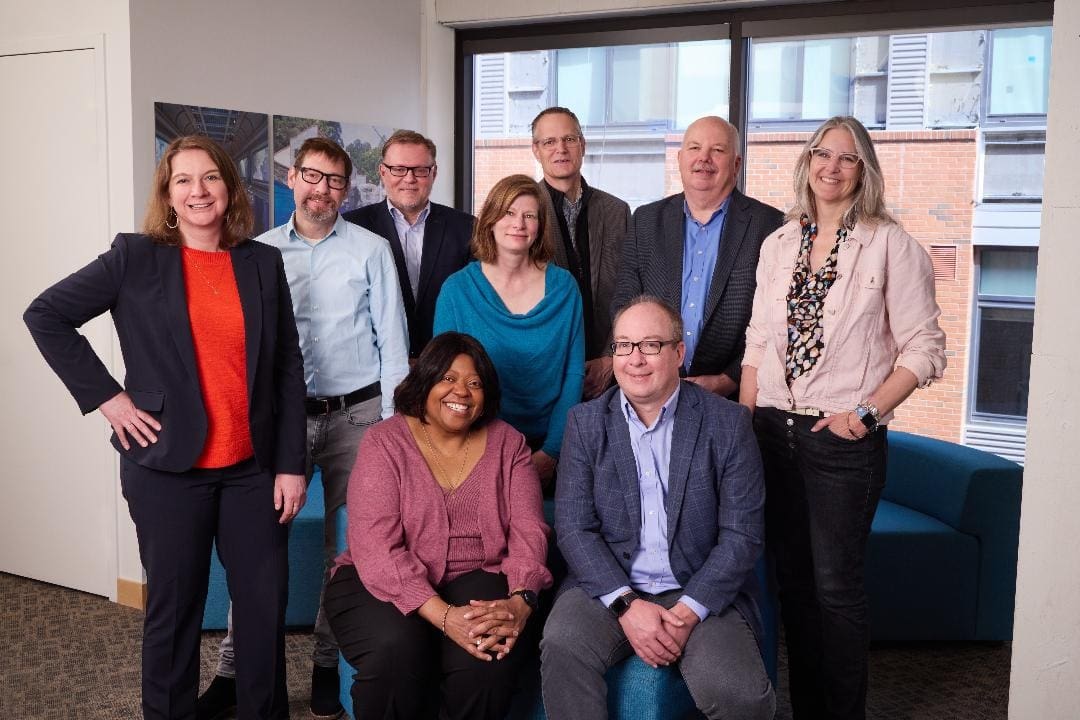Expanded Board to Guide Design Firm’s Strategic Growth; Create New Research Fellowship in Sustainable and Inclusive Design

Front Row (L to R): Saundra Little, Thomas Jester
Back Row (L to R): Kathryn Slattery, Brian Oster, Richard Hess, Alyson Steele, Charles Piper, Larry Barr, Ann Dilcher
Quinn Evans has announced the expansion of its board of directors with three new members: Kathryn Slattery, AIA, LEED AP BD+C; Richard Hess, AIA; and Saundra Little, FAIA, LEED AP, NOMA. The expansion adds a diversity of experience and perspectives to the management of the organization, which employs more than 200 in six offices throughout the Midwest and mid-Atlantic.
All three of the new members are architects and principals with the firm. Kathryn Slattery joined Quinn Evans in 2003 and is based in the Washington, D.C., office. Richard Hess has been with the firm since 2005 and is based in the Detroit office. Saundra Little joined Quinn Evans in 2019 and is also based in Detroit. She serves as director of diversity and inclusion for the firm.
The board now consists of the following members:
- Alyson Steele, FAIA, LEED AP, President and CEO
- Tom Jester, FAIA, FAPT, LEED AP, Principal and Chief Operating Officer
- Ann Dilcher, FAIA, LEED AP, Principal
- Brian Oster, AIA, Principal
- Charles Piper, AIA, Principal
- Kathryn Slattery, AIA, LEED AP BD+C, Principal
- Richard Hess, AIA, Principal
- Larry Barr, FAIA, Senior Principal and Immediate Past President – non-voting
- Saundra Little, FAIA, LEED AP, NOMA, Principal – non-voting
The board of directors provides high-level advice, guidance, and fiduciary oversight to the Quinn Evans executive team, and selects officers as well as the trustees for the firm’s 401k plan. All of the members reflect excellence in professional practice, management, and mentoring. The board now includes two non-voting, non-shareholder members for the first time, with a goal of enriching the board’s counsel with additional insights and expertise.
With deep expertise in the cultural, academic, preservation, and community revitalization markets, Quinn Evans has consistently demonstrated industry leadership in the fields of sustainable stewardship and inclusive design. “The evolution of our board reflects the design of our firm,” states Alyson Steele, who was recently elected president and CEO. “Ownership and leadership transitions continue in parallel over time, providing forward momentum that ensures that we remain true to our mission while preparing for the future. I’m grateful for the commitment and engagement of all members—past, present, and future.”
Decisions by the new board at its first meeting in April included the establishment of a one-year research fellowship focusing on analysis and design practices for the built environment that advance sustainable stewardship and inclusive design. Within these larger fields, projects may delve into historic building and landscape information management, landscape and building science, hybrid envelope performance, and life-cycle carbon assessment. Quinn Evans will create an internal steering committee to oversee the fellowship position with the award of the initial fellowship in the fall of 2022.
About Quinn Evans
Established in 1984, Quinn Evans provides services in architecture, interior design, planning, landscape architecture, urban revitalization, and historic preservation, including sustainable preservation and stewardship. The firm has more than tripled in size over the past five years, with 200 professionals in six office locations in Washington, D.C.; Ann Arbor and Detroit, Michigan; Madison, Wisconsin; Baltimore, Maryland; and Richmond, Virginia. Nationally ranked in its sustainability practice, Quinn Evans is a charter signatory of the AIA 2030 Challenge and a member of the Center for the Built Environment.
Quinn Evans specializes in cultural, institutional, commercial, and educational projects, including museums, historic parks, theaters, mixed-use buildings, schools and campus facilities, libraries, and civic landmarks. Current projects for the firm include the modernization of the National Air and Space Museum and the renovation of the Lincoln Memorial in Washington, D.C.; renovation of the Old City Hall and Virginia Commonwealth University’s new STEM building in Richmond, Va.; and the redevelopment of Baltimore’s Penn Station.
Additional projects underway include the design of security improvements to support ferry transit operations to Ellis Island and the Statue of Liberty and the restoration of the Cape Hatteras Lighthouse in North Carolina, both for the National Park Service. For Ford, Quinn Evans is currently designing the restoration and adaptive use of the landmark Michigan Central Station in Detroit. Other Michigan projects include the adaptive use of the Walter French High School into housing in Lansing and the Farmer’s Market at the Henry Ford Greenfield Village. For more information, visit www.quinnevans.com.






